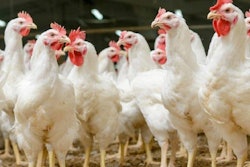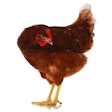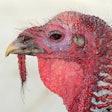
Thanks to the recent re-opening of the market, China is now the leading destination for U.S. chicken exports.
As part of the USA Poultry & Egg Export Council’s (USAPEEC) 2020 Virtual Annual Meeting, on June 9, 2020, USAPEEC President Jim Sumner spoke about the impact of the COVID-19 pandemic on the global industry and the early returns for 2020.
COVID-19 rocks the world
The global pandemic of COVID-19 is driving change around the world and shaking economies, but the global poultry industry for the most part is avoiding any serious work stoppages caused by the virus.
Sumner said the goal of the U.S. poultry industry and its support organizations is uniform: keeping plants open and processing. Globally, the objective is to keep markets open and let the international trade of poultry and eggs flow freely.
So far, the industry is continuing to function and governing bodies around the world are cooperative. The biggest problem right now is the rapid, seismic demand shift from foodservice to retail and the accompanying lack of processing infrastructure to meet the new demand.
Poultry exports remain strong
Despite the global challenges, U.S. broiler exports are doing well, Sumner said. Through the first four months of 2020, broiler exports volume is up 9% compared with the same period of 2019. Broiler export values increased by 18%. The volume of turkey exports fell by 7% while value increased by 6%.
Shell egg products were up 11% in volume and 27% in value while processed egg products were up 18% in volume and 26% in value.
These were some of the most impressive numbers ever seen, he said, and could be credited to China’s re-opening to U.S. broiler exports at the end of last year.
China becomes leading export destination
Between January 2020 and April 2020, China imported a total of 99,875 tons of broiler products. Out of that 44% were chicken paws. Sumner expected a higher percentage of paws, since the product is popular in the country and almost all the integrators in the U.S. are now sending paws. Nevertheless, that product percentage indicates strong performance for U.S. products in the country.
In April alone, 53,000 tons of broilers were exported to China so trade is only beginning to start opening up, he said. Now, 19% of the U.S.’ global poultry exports – and 25% of the value of U.S. exports go to China – which makes the country its largest export partner, surpassing Mexico. U.S. imports into China, however, continue to face a retaliatory, 30% tariff as well as stiff competition from Brazil.
Sumner said the situation in China will continue to be relatively unpredictable, but he’s optimistic for the future of the trading relationship. While Brazil is sending 4 times as much chicken to China as the U.S., it is rapidly becoming a COVID-19 hotspot. The U.S. continues to supply the highest-quality chicken paws in the world, too.
Additionally, China faces significant animal disease and protein shortage challenges. The bottom line is, Sumner said, the Chinese government does not want its people to go hungry and must ensure an adequate supply of protein.
Mexico and other export destinations
Elsewhere in the world, in the first four months of 2020, U.S. exports grew in Mexico, Vietnam, the Philippines and Georgia by a cumulative 164,300 metric tons compared with the same period of 2019. Exports fell in Hong Kong, Angola, Cuba, Haiti and Iraq by a cumulative 92,000 metric tons.
Sumner said Mexico’s increase in imports was due to a policy decision by the Mexican government to end a system which gave Brazil unprecedented access to Mexico. The Mexican consumer is beginning to choose more breast meat, too, he said. The increase in Vietnam was due to African swine fever (ASF).
The drop in exports, he said, was related to political unrest in Hong Kong as well as that region no longer being necessary as a conduit for U.S. product to flow into mainland China. Elsewhere around the world, COVID-19 disrupted the market for poultry.
Turkey exports grew in China, Mexico, South Korea, Canada and Guinea by a cumulative 9,300 metric tons. They fell in Benin, South Africa, Peru, Japan and Hong Kong by a cumulative 9,305 metric tons.
In Mexico, Sumner said turkey shipments increased because of a higher pork prices in Mexico because of ASF. The largest losses for turkey came in Africa where price is king and lower priced competitors can undercut demand for U.S. turkey.



















